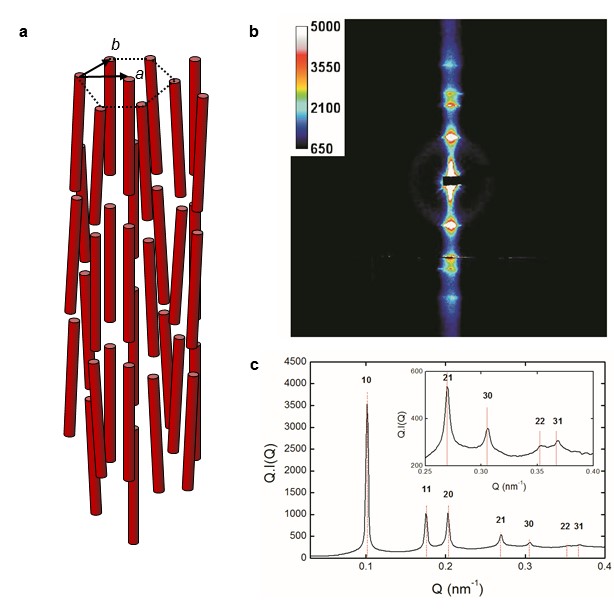The surprising self-organization of nanotubes in a very dilute columnar liquid-crystal phase
2017-11-07
Liquid crystals have found wide applications in many fields ranging from detergents to information displays. They are an important class of “soft matter” and they are increasingly being used in the “bottom-up” self-assembly approach of the nano-structuration of materials. Moreover, liquid-crystalline organizations are frequently observed by biologists. A research team of the LPS, in collaboration with researchers from CEA-Saclay (NIMBE-LIONS), has recently discovered that one of the four major lyotropic liquid-crystal phases, the columnar one, is actually much more stable (by a factor 100 in concentration!) than considered up to now.
Nanotubes (or nanorods) in colloidal suspensions form a columnar liquid-crystal when they spontaneously organize parallel to each other, on a two-dimensional lattice perpendicular to their axes, like a bunch of pencils (Figure a). This organization was so far only expected in concentrated suspensions where the nanorods are close to contact. Here, researchers at LPS and LIONS have shown that very dilute suspensions of clay imogolite nanotubes form a columnar liquid-crystal. Imogolites are aluminosilicates (or aluminogermanates) that have raised increasing interest in the last decade. In contrast with carbon nanotubes, they are easily obtained by sol-gel processes at low temperature. Moreover, the presence of hydroxyl groups on their surface makes these nanotubes quite hydrophilic, which allows producing aqueous suspensions.

Figure: a) Schematic representation of the organisation of the nanotubes in the columnar hexagonal liquid-crystalline phase (a et b are the unit vectors of the hexagonal lattice) ; b) Small angle X-ray scattering pattern of the columnar phase aligned in an electric field; c) Structure factor showing the reflections (indicated by the red lines) of the hexagonal lattice.
Texture observations of very dilute suspensions (volume fraction ~ 0.3%) by polarized-light microscopy revealed the existence of an unexpected liquid-crystalline phase. Small-angle X-ray scattering measurements, performed at the SOLEIL synchrotron (Swing beamline) showed that this new phase is a columnar hexagonal liquid crystal (Figure b, c).
Despite the high dilution, the nanotubes are perfectly organized on a hexagonal lattice with a spacing (~ 80 nm) fifteen times larger than the nanotube diameter. This dilute liquid-crystal is so fluid that the nanotubes are easily aligned in an electric field, which is a prerequisite for future applications. This work has important implications for the statistical physics of colloidal suspensions of charged rod-like particles, like biopolymers, and their fundamental understanding. It also opens new perspectives, for instance, in the field of nanocomposite materials where the organization of anisotropic particles is required to improve physical properties.
Reference
Paineau E., Krapf, M.E.M., Amara M.S., Matskova, N.V., Dozov, I., Rouzière S., Thill, A., Launois, P. et Davidson, P.. A liquid-crystalline hexagonal columnar phase in highly-dilute suspensions of imogolite nanotubes. Nat. Commun., 7, 10271 (2016)
Contacts
Erwan Paineau (erwan-nicolas.paineau@u-psud.fr)
Patrick Davidson (patrick.davidson@u-psud.fr)
Laboratoire de Physique des Solides, CNRS, Univ. Paris Sud, Université Paris Saclay, 91405 Orsay cedex, France